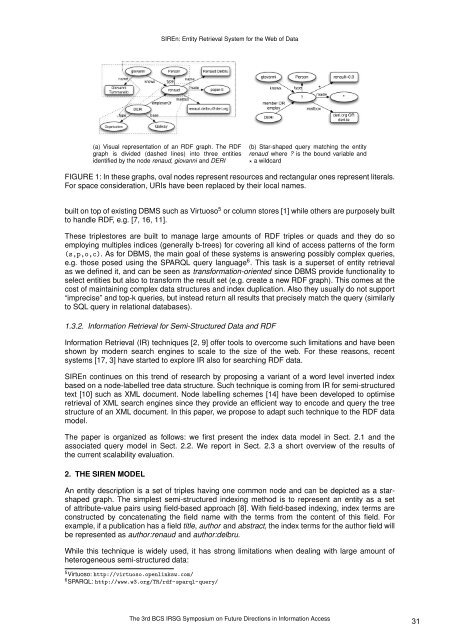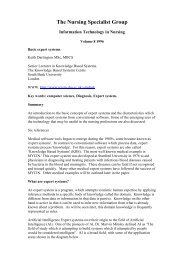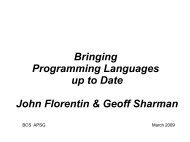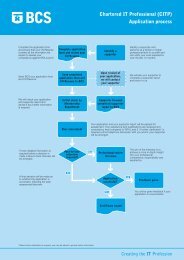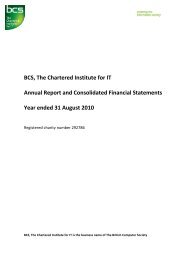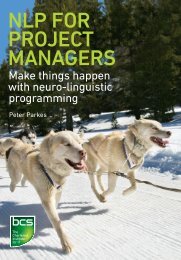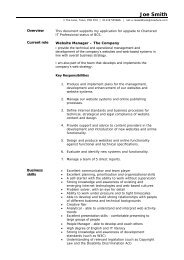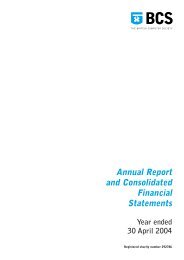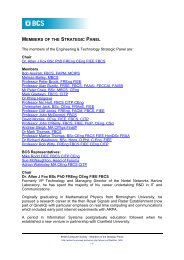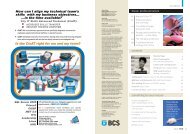SIREn: Entity Retrieval System for the Web of Data - BCS
SIREn: Entity Retrieval System for the Web of Data - BCS
SIREn: Entity Retrieval System for the Web of Data - BCS
- TAGS
- entity
- retrieval
- www.bcs.org
Create successful ePaper yourself
Turn your PDF publications into a flip-book with our unique Google optimized e-Paper software.
<strong>SIREn</strong>: <strong>Entity</strong> <strong>Retrieval</strong> <strong>System</strong> <strong>for</strong> <strong>the</strong> <strong>Web</strong> <strong>of</strong> <strong>Data</strong><br />
(a) Visual representation <strong>of</strong> an RDF graph. The RDF<br />
graph is divided (dashed lines) into three entities<br />
identified by <strong>the</strong> node renaud, giovanni and DERI<br />
(b) Star-shaped query matching <strong>the</strong> entity<br />
renaud where ? is <strong>the</strong> bound variable and<br />
⋆ a wildcard<br />
FIGURE 1: In <strong>the</strong>se graphs, oval nodes represent resources and rectangular ones represent literals.<br />
For space consideration, URIs have been replaced by <strong>the</strong>ir local names.<br />
built on top <strong>of</strong> existing DBMS such as Virtuoso 5 or column stores [1] while o<strong>the</strong>rs are purposely built<br />
to handle RDF, e.g. [7, 16, 11].<br />
These triplestores are built to manage large amounts <strong>of</strong> RDF triples or quads and <strong>the</strong>y do so<br />
employing multiples indices (generally b-trees) <strong>for</strong> covering all kind <strong>of</strong> access patterns <strong>of</strong> <strong>the</strong> <strong>for</strong>m<br />
(s,p,o,c). As <strong>for</strong> DBMS, <strong>the</strong> main goal <strong>of</strong> <strong>the</strong>se systems is answering possibly complex queries,<br />
e.g. those posed using <strong>the</strong> SPARQL query language 6 . This task is a superset <strong>of</strong> entity retrieval<br />
as we defined it, and can be seen as trans<strong>for</strong>mation-oriented since DBMS provide functionality to<br />
select entities but also to trans<strong>for</strong>m <strong>the</strong> result set (e.g. create a new RDF graph). This comes at <strong>the</strong><br />
cost <strong>of</strong> maintaining complex data structures and index duplication. Also <strong>the</strong>y usually do not support<br />
“imprecise” and top-k queries, but instead return all results that precisely match <strong>the</strong> query (similarly<br />
to SQL query in relational databases).<br />
1.3.2. In<strong>for</strong>mation <strong>Retrieval</strong> <strong>for</strong> Semi-Structured <strong>Data</strong> and RDF<br />
In<strong>for</strong>mation <strong>Retrieval</strong> (IR) techniques [2, 9] <strong>of</strong>fer tools to overcome such limitations and have been<br />
shown by modern search engines to scale to <strong>the</strong> size <strong>of</strong> <strong>the</strong> web. For <strong>the</strong>se reasons, recent<br />
systems [17, 3] have started to explore IR also <strong>for</strong> searching RDF data.<br />
<strong>SIREn</strong> continues on this trend <strong>of</strong> research by proposing a variant <strong>of</strong> a word level inverted index<br />
based on a node-labelled tree data structure. Such technique is coming from IR <strong>for</strong> semi-structured<br />
text [10] such as XML document. Node labelling schemes [14] have been developed to optimise<br />
retrieval <strong>of</strong> XML search engines since <strong>the</strong>y provide an efficient way to encode and query <strong>the</strong> tree<br />
structure <strong>of</strong> an XML document. In this paper, we propose to adapt such technique to <strong>the</strong> RDF data<br />
model.<br />
The paper is organized as follows: we first present <strong>the</strong> index data model in Sect. 2.1 and <strong>the</strong><br />
associated query model in Sect. 2.2. We report in Sect. 2.3 a short overview <strong>of</strong> <strong>the</strong> results <strong>of</strong><br />
<strong>the</strong> current scalability evaluation.<br />
2. THE SIREN MODEL<br />
An entity description is a set <strong>of</strong> triples having one common node and can be depicted as a starshaped<br />
graph. The simplest semi-structured indexing method is to represent an entity as a set<br />
<strong>of</strong> attribute-value pairs using field-based approach [8]. With field-based indexing, index terms are<br />
constructed by concatenating <strong>the</strong> field name with <strong>the</strong> terms from <strong>the</strong> content <strong>of</strong> this field. For<br />
example, if a publication has a field title, author and abstract, <strong>the</strong> index terms <strong>for</strong> <strong>the</strong> author field will<br />
be represented as author:renaud and author:delbru.<br />
While this technique is widely used, it has strong limitations when dealing with large amount <strong>of</strong><br />
heterogeneous semi-structured data:<br />
5 Virtuoso: http://virtuoso.openlinksw.com/<br />
6 SPARQL: http://www.w3.org/TR/rdf-sparql-query/<br />
The 3rd <strong>BCS</strong> IRSG Symposium on Future Directions in In<strong>for</strong>mation Access<br />
31


